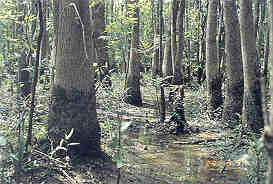Simply put, wetlands are “in-between” areas that have something of both dry uplands and open water environments: they are neither “land” nor “water” – they are a transition zone, which is what makes them so interesting. Wetlands have both upland and aquatic characteristics, and, thus, they often have a richer flora and fauna than other environments.

The high water line on these tupelo trees is an indication of the hydrology of this swamp - deep water for two to three months each year. (Texas Parks and Wildlife)
In practice, wetlands are hard to define, precisely because they are transition zones. It is important to recognize that an area does not have to be wet all year long to be considered a wetland – as few as two or three consecutive weeks of wetness a year is all it takes! The hydrology of a wetland (how much water it gets and how long it stays there) is the most important factor that determines its character. Because oxygen does not move very fast in water, water saturation very quickly results in a soil condition known as anaerobiosis, which refers to very low oxygen content. A lack of oxygen kills most plants, and hydrophytic or ` is the only kind of vegetation that can survive in these conditions. The reeds and rushes that are common in many wetlands can survive because they have hollow stems that allow them to push oxygen down into the saturated root zone. Other wetland plants have developed different strategies for surviving in the anaerobic environment. Waterlogged soils develop particular kinds of color patterns that make them recognizable as wetland or hydric soils. Hydric soils are typically gray and may have reddish stains along root channels. Wetland scientists use wetland hydrology, hydrophytic vegetation, and hydric soils to help them determine whether a given area is a wetland and the kind of wetland it is. We will examine each of these characteristics when we describe each of the major wetland types that occur on the Texas coastal plain.